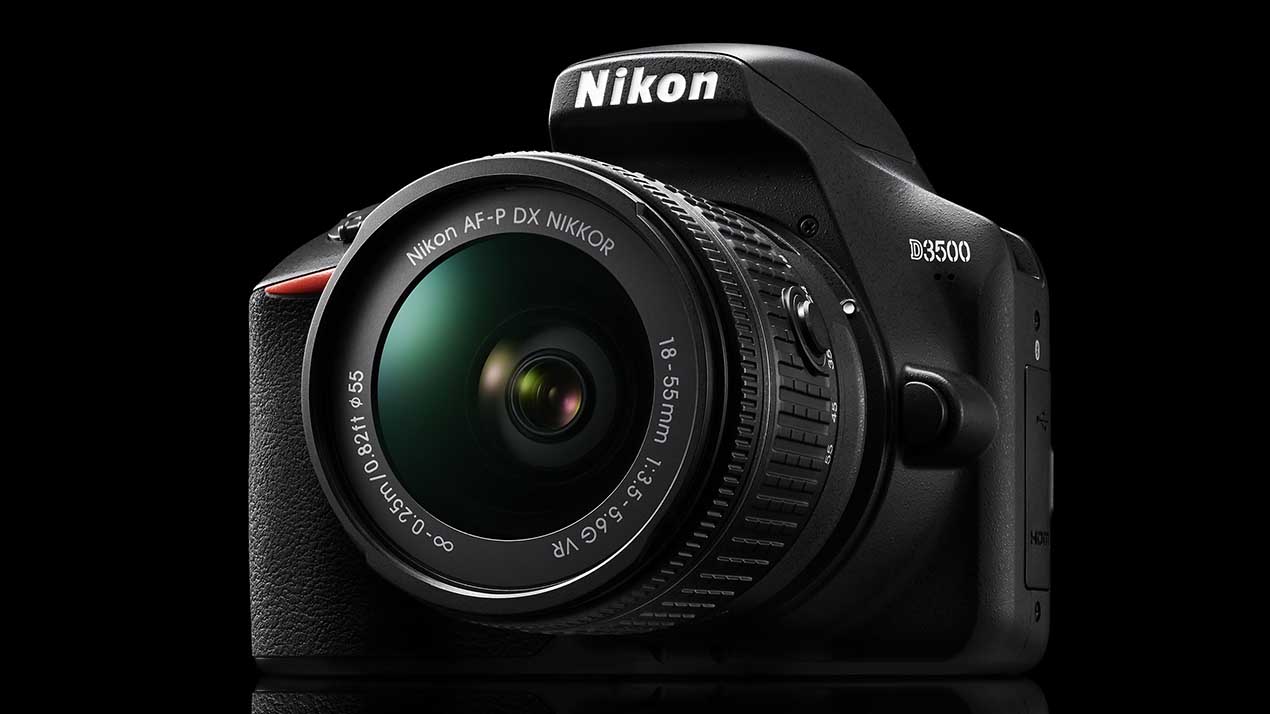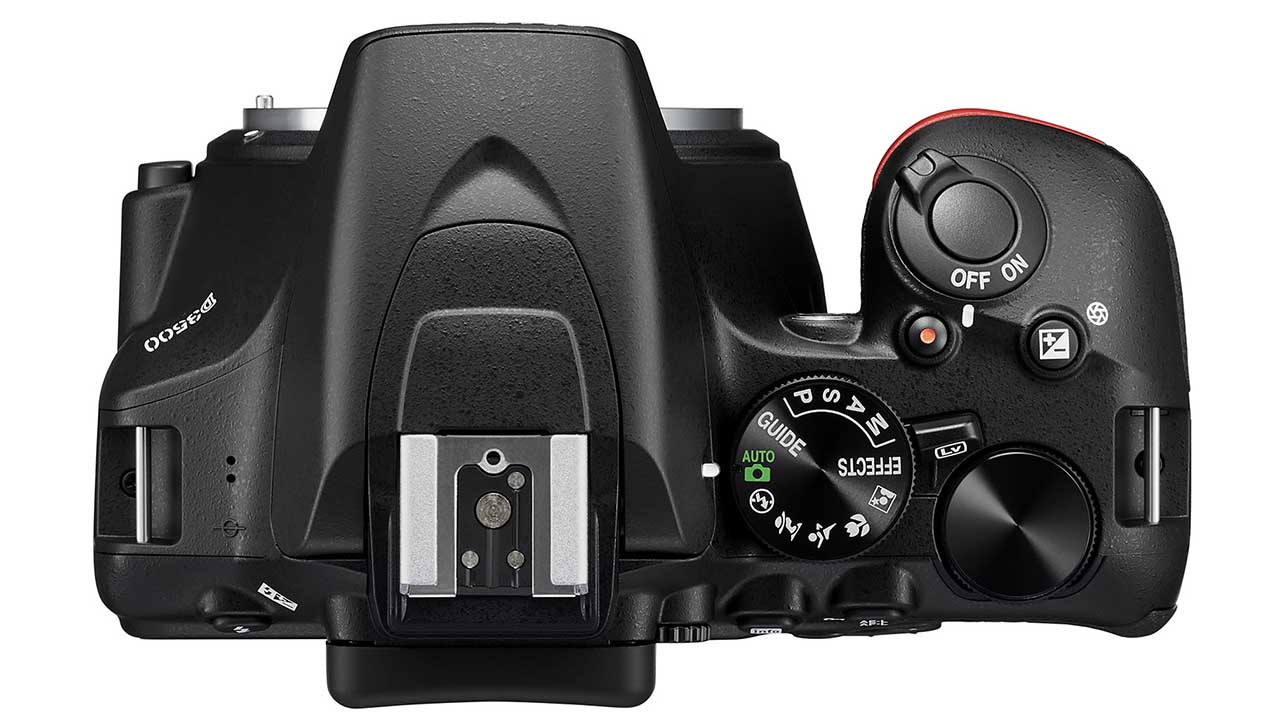The Nikon D3500 is Nikon’s entry-level DSLR and while it was announced in August 2018, it is still current and is available at a very attractive price.
Our Verdict
For years, Nikon’s D3XXX series of cameras has been my recommendation for anyone looking for their first DSLR. Having replaced the D3400 in August 2018, the Nikon D3500 is the most recent model in the line. While it has a very similar specification as the camera it replaced, the D3500’s APS-C format 24.2Mp sensor is newer (although it has the same effective pixel count as the previous chip). In addition, it’s a little lighter than the D3400 and its battery lasts for a few more shots. Nikon has also tweaked its design a bit in comparison with the D3400.
For
- Excellent 24Mp APS-C format sensor
- Superb guide mode that teaches you about photography
- Compatible with an extensive range of lenses and accessories
Against
- Max video resolution is Full HD
- Fixed screen
What is the Nikon D3500?
Specification
- Camera type: APS-C (DX) format DSLR
- Announced: 30th August 2018
- Lens mount: Nikon F
- Sensor: 24.2Mp APS-C (23.5 x 15.6mm)
- Sensitivity range: ISO 100-25,600
- Autofocus system: Viewfinder: 11-point with 1 cross-type, Live View: Contrast detection
- Maximum continuous shooting rate: 5fps (frames per second)
- Viewfinder: Optical with pentamirror 95% coverage
- Screen: 3-inch TFT LCD with 921,000 dots
- Storage: SD/SDHC/SDXC UHS-I
- Dimensions: 124 x 97 x 69.5mm
- Weight: 365g body only
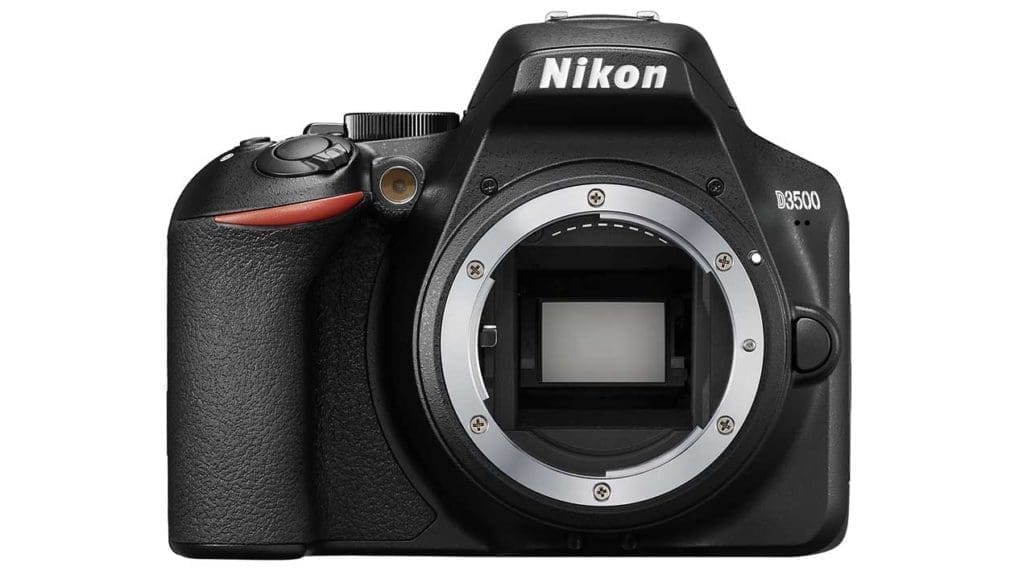
Features
Unlike most recently announced cameras, the Nikon D3500 is a DSLR. That means it has a mirror and an optical viewfinder. Having an optical viewfinder helps give the D3500 much longer battery life than the average mirrorless camera, but it also means that you can’t see the impact of setting changes in there. If you switch to live view mode and compose images on the viewfinder, you’ll see the exposure change if you make an adjustment, but it’s not possible in the viewfinder.
As the D3500’s viewfinder shows 95% of the image that is captured, there’s a chance that you may include a few unseen objects around the edge of the frame. They can easily be cropped out, but it’s worth having a quick look around before you press the shutter release.
The D3500 has the same effective pixel count as the D3400. As it’s an APS-C format sensor, it’s much bigger than the sensors in mobile phones and most compact cameras. That’s good news for image quality and it also means you get much more control over depth of field so it’s far easier to blur the background of a portrait.
The sensor is paired with Nikon’s Expeed 4 processing engine.
Nikon has stuck with the same sensitivity range, ISO 100-25,600, as with the D3400.
Video
Given the predominance of 4K video capability in mirrorless cameras, it’s disappointing that Nikon has limited the D3500 to Full HD (1920 x 1080) video, but it’s possible to shoot in 60p/50p/30p/25p/24p.
There’s also no headphone or mic port and the screen is fixed, which isn’t ideal for video.
Autofocus
In addition to the imaging sensor that has 24.2million effective pixels, there’s also a sensor that’s dedicated to the phase detection autofocus (AF) system. This is the 11-point AF system that operates when images are composed in the viewfinder.
The D3500 can also focus automatically when images are composed on the screen, but this uses information drawn from the imaging sensor and it relies on contrast detection.
Screen
As I mentioned earlier, the D3500’s 3-inch 921,000-dot screen is fixed, which means it can’t be tilted to give a better view when shooting above or below head height. It’s also not touch-sensitive.
That helps keep the price down, but if you want that extra functionality, check out the Nikon D5600 or the mirrorless Nikon Z50.
Nikon D3500 Battery
Like the D3400, the Nikon D3500 uses Nikon’s EN-EL14a rechargeable Li-ion battery. However, Nikon has managed to extend the D3500’s battery life by 30%. This means that it’s capable of powering around 1,550 shots on a single charge. That’s up from 1,200 shots with the D3400.
Most photographers using a mirrorless camera would be very envious of such an impressively long battery life.
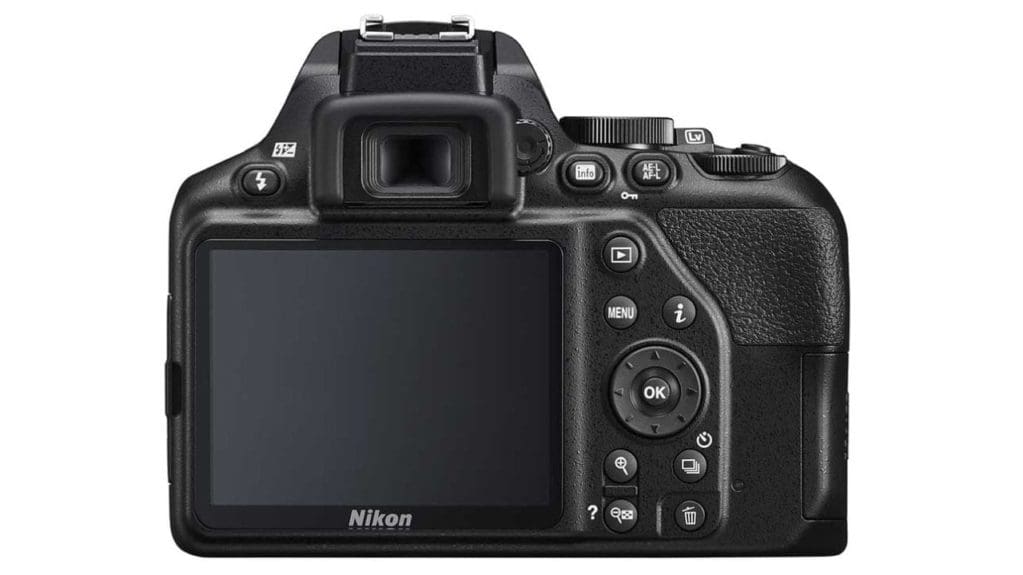
Build and Handling
In a change from the D3400, the Nikon D3500 has a monocoque construction – like the Nikon D5600. This means that there are fewer joints in the body and it’s a bit lighter than the D3400.
Although the D3500 doesn’t feel quite as tough as cameras further up Nikon’s DSLR line, it feels reasonably good for an entry-level model. The grip is particularly impressive as it’s nice and deep. Nikon has made the body thin so that the deep grip doesn’t increase the overall size.
The D3500 has an uncomplicated control arrangement with a smattering of buttons across its back and a mode dial, command dial and two buttons plus the shutter release on its top plate. The exposure compensation button sits just behind and to the right of the shutter button, so it’s easy to locate when you’re looking in the viewfinder.
In manual exposure mode, the exposure compensation button is used in conjunction with the command dial to set the aperture.
I find the command dial perfectly placed for making setting adjustments.
Pressing the Info button on the back of the D3500 brings up the status screen that shows the most important settings. This fish just for reference, you can’t use it to adjust the settings.
However, pressing the ‘i’ button reveals a grid of up to 12 features that can be selected and adjusted. These include parameters such as the sensitivity (ISO), white balance and AF-area mode. As the 3-inch 9210,000-dot screen isn’t touch-sensitive, these features have to be selected and adjusted using the navigation pad and OK button. It’s very easy, just not as fast as using a touchscreen.
Viewfinder and Screen
As it’s a DSLR rather than a mirrorless camera, the D3500 has an optical viewfinder. This has a pentamirror rather than the more luxurious pentaprism construction, but it provides a decent view.
Like most DSLRs at this price point, the D3500’s viewfinder can only show 95% of the image. That means you need to take care not to include objects around the edge of the frame. Of course, you can crop out any unseen and unwanted objects, but it’s nice to avoid it if you can.
As it’s not electronic, the viewfinder can’t show the impact of camera settings. That means you won’t see if the image is going to be under or overexposed. You also won’t see the impact of the Creative Effects, but the word Creative is visible to warn you that the mode is selected.
If you’re shooting in Live View mode, however, the impact of any camera settings is shown on the screen. The demand on the processor has an impact in some of the Creative Effect modes and the screen becomes quite laggy. In other modes, however, the screen provides a good view although, as it’s fixed you can’t tilt it to give a better view when you’re shooting above or below head-height.
Guide Mode
As shown above, the D3500’s mode dial has a Guide setting that activates the Guide mode. This is very useful for anyone getting to grips with photography. It helps you take control of the camera to get the results that you want and it uses simple, non-technical language.
The best part is that it explains what settings you are adjusting so that it helps you learn about photography and ultimately, control the camera directly.
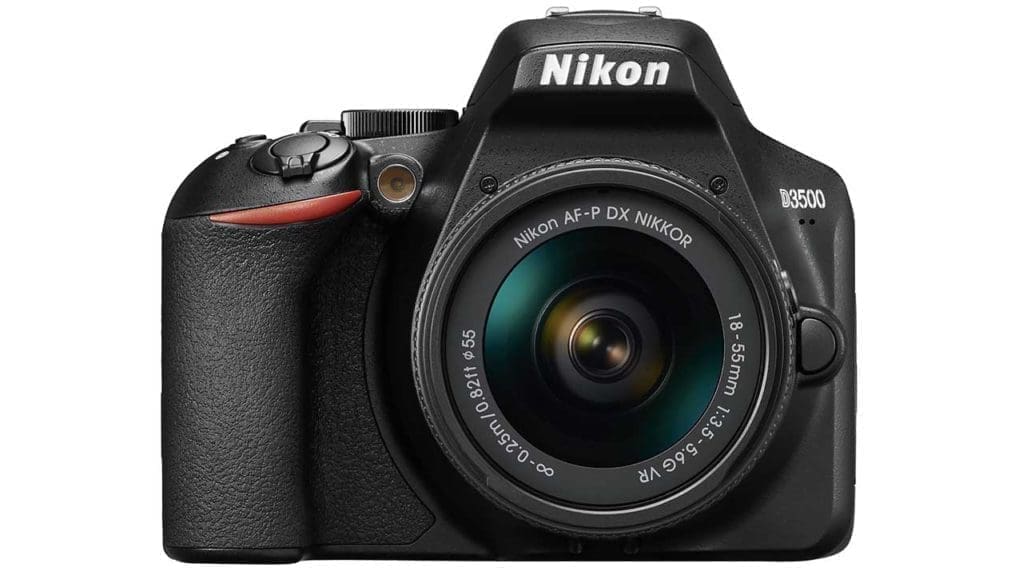
Performance
One thing that’s clear after shooting with the Nikon D3500 for a few days, is that it turns out good results in a wide range of situations. The matrix metering system seems to have an almost psychic understanding of the subject and the image you want to create. There were several times when I expected it to underexpose a bright scene, for instance, and it delivered a perfect result. And yet, when I wanted to shoot a silhouette of some horses against a sunset, it got that just right too.
Inevitably, there are a few occasions when you need to use the exposure compensation, but fewer than you might expect and never when an experienced photographer wouldn’t anticipate it.
Nikon D3500 Autofocus performance
It may be an entry-level camera, but the D3500’s phase detection autofocus (AF) is very good. With just 11 AF points there are times when you need to use the focus-and-recompose technique, but it gets the subject sharp.
When the active AF point is over a subject it gets in focus very quickly. It can also keep a moving subject sharp as it moves towards or away from the camera.
The contrast-detection AF system that operates when images are composed on the screen (ie in Live View mode) is also very capable. In decent light and with a Nikon AF-P lens mounted, it gets the subject sharp quite quickly. Its performance drops off in low light or when an AF-S lens is mounted.
It can’t focus as quickly in Live View mode as the mirrorless Nikon Z50 does.
Image Quality
I’ve no complaints about the quality of the images that the D3500 delivers. The level of detail is what I’d expect from a 24Mp APS-C format sensor and noise is controlled well.
Raw files shot at ISO 25,600 have a fine, uniform texture of luminance noise. However, there’s no clumping or banding. The texture is processed out from Jpegs shot at the same value. This is at the expense of the finer details and some objects look a bit too smooth at 100% on-screen. If you can, shoot raw files to get more natural results. They also give you control over noise reduction.
The D3500 has a collection of Picture Control modes that determine the colour and contrast of Jpegs. I find the Standard setting a good default option, but Landscape mode is handy to beefing-up the colours of some landscapes. Vivid mode can be useful for this as well, but keep an eye on grass and vegetation in case it becomes too vivid.
Nikon’s automatic white balance system also delivers good results in many situations. It leaves a slight colour cast in some artificial light, but that’s not usual. I find the Cloud or Shade setting useful in the gloom of a British January.
Sample Images
Follow the link to browse and download full-resolution images.
[FAG id=100604]
Verdict
If you’re looking for your first DSLR, the D3500 is a great choice. The Guide Mode is especially useful. It’s still the best around for helping photographers get to grips with their camera. It’s especially nice that it’s built into the camera rather than relying on a smartphone app.
While it would be nice to have a vari-angle touchscreen, that would push up the price of the D3500. It’s designed to be an entry-level, affordable option.
However, Nikon hasn’t skimped on the sensor and it delivers high-quality results with a good level of detail. The camera is also tuned to help beginners get decent images in a wide range of situations.
The ability to see the impact of settings changes is a distinct advantage of electronic viewfinders, especially for novices. However, many photographers still like the optical finder offered by DSLRs.

